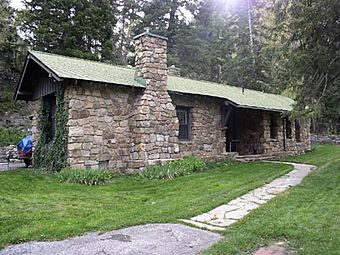Timpanogos Cave Historic District facts for kids
Quick facts for kids |
|
|
Timpanogos Cave Historic District
|
|

Superintendent's residence, March 2007
|
|
| Nearest city | Highland, Utah |
|---|---|
| Area | 11 acres (4.5 ha) |
| Built | 1921-1941 |
| Architect | Multiple |
| Architectural style | Rustic |
| NRHP reference No. | 82001760 |
| Added to NRHP | October 13, 1982 |
The Timpanogos Cave Historic District is a special area covering about 11 acres (4.5 ha) inside the Timpanogos Cave National Monument. It is located in American Fork Canyon in Utah County, Utah. This district is a collection of old buildings and trails. They were built a long time ago, between 1921 and 1941. It is listed on the National Register of Historic Places (NRHP). This means it's an important place in history.
Contents
What is the Timpanogos Cave Historic District?
This historic district includes buildings and trails that helped people visit the Timpanogos Cave. They were built in the 1920s and 1930s. These structures are great examples of the National Park Service Rustic style. This building style uses natural materials like stone and wood. It makes buildings look like they belong in the natural landscape.
Early Buildings and Trails
The first trails and buildings were made by Errol M. Halliday. This was when the area was managed by the United States Forest Service. The Old Cave Trail was built in 1921 and 1922. A stone storage building was also built in the 1920s. There was once a wooden house for the park's caretaker, but it is no longer there. A stone comfort station, which is like a public restroom, was built in 1928.
Buildings and Features
The buildings are spread out on a steep hillside. The most important building is the superintendent's residence. This house is made of rough stone. Its roof is made of logs and covered with green shingles.
A bridge was built in 1935, also using rough stone. Another comfort station, now called the Last Chance restroom, was built in 1935. It sits on a ledge on the mountain. It has a flat concrete roof covered with stone. The older 1928 comfort station is bigger and has a shingled roof. It is not used as a restroom anymore. The stone storage building has a flat concrete roof. There are also two cold cellars, built around 1930. These were used to keep things cool.
The trail itself is quite a climb. It goes up the cliffs for about 1.5 miles (2.4 km). It climbs about 1,065 feet (325 m) in height. Stone walls help support the trail along the way.
History of the District
The National Park Service started managing the monument in 1933. More buildings were added with help from the Works Progress Administration (WPA). The WPA was a government program that provided jobs during the Great Depression. They built another comfort station in 1939.
A stream flows through American Fork Canyon. It becomes the American Fork River. This stream was moved, and a new bridge was built in the 1930s. The superintendent's residence, the main house, was finished in 1941.
The Timpanogos Cave Historic District was officially added to the National Register of Historic Places on October 13, 1982. This recognized its importance in American history and architecture.



